Welcome to Part 4 of the MMA Training Bible’s article series on periodization. In Part 1 of the series, you learned that periodization is the process of organizing your training into different phases to the end of managing fatigue, lowering your potential for overtraining, and optimizing your performance on fight day. In Part 2, you learned all about the big phases; the general preparation phase, the fight-specific preparation phase, the fight camp, the taper, and the transition. Part 3 moved one level down and showed you how to organize the sub-phases. In the present article, we’re going to go down one step further and show you how to organize your training weeks.
Just in case you’ve forgotten what the whole fight schedule looks like, here it is again (you should be able to draw this from memory by now).
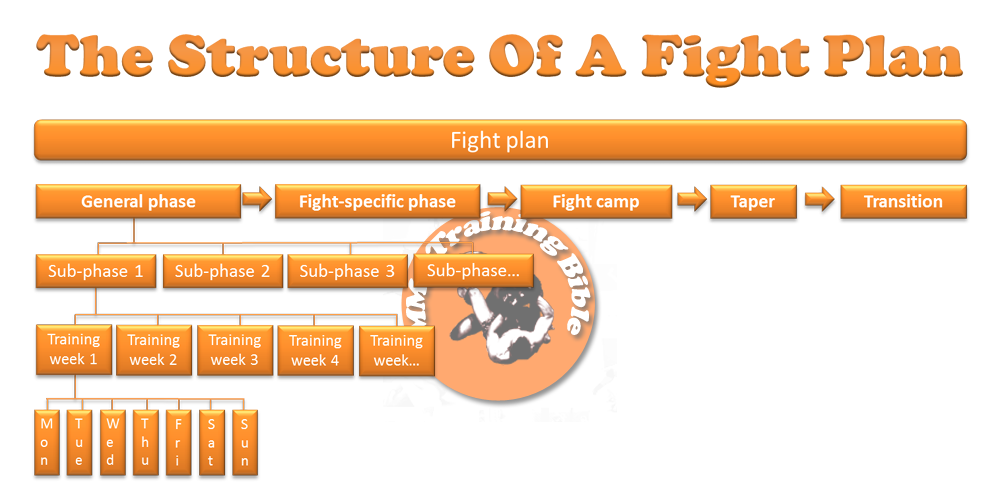
You can see from the figure that each sub-phase is divided into training weeks. Although the training week is a small cycle (it is made up of the days of the week), it is probably the most important element of the entire fight plan because it lays out your day-to-day training schedule. It is also the most difficult to plan in advance because many unpredictable factors influence the number of days that you can train per week, from social and work/study commitments, to gym timetables and your level of fatigue. For this reason, you should not plan more than a few training weeks into the future.
There are four different types of training weeks that you should know about. They can be classified as developmental (DEV), shock (SHOCK), recovery (REC), or peaking (PEAK) (1). It is relatively straight forward to assign these training weeks to the fight plan. I want to go into a bit of detail about each of these; let’s start with recovery training weeks.
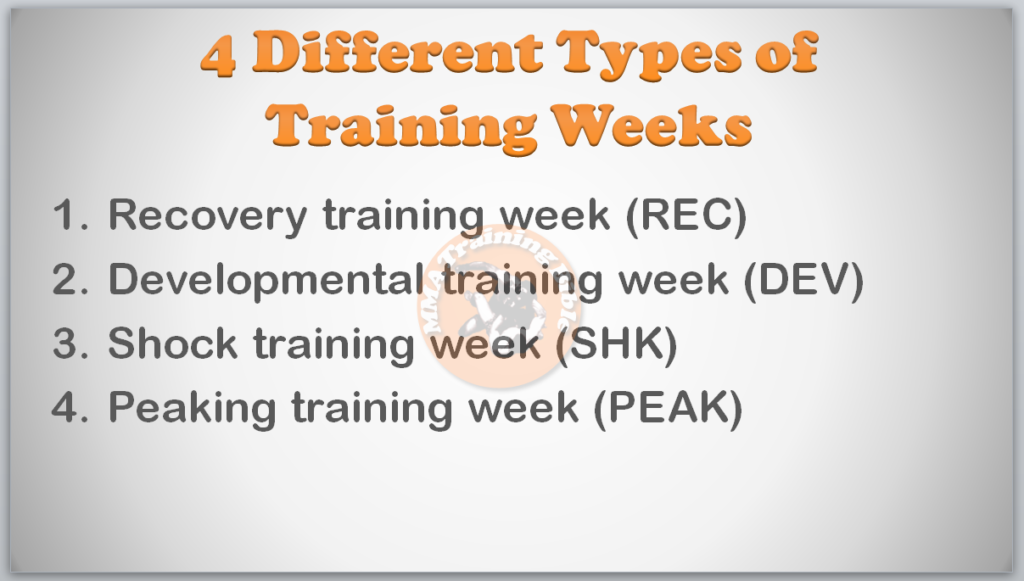
Recovery training weeks
Recovery training weeks are designed to dissipate fatigue and elevate your adaptation from previous shock training sub-phases. Recover training weeks absolutely essential in helping you avoid over-training. If you’re a fighter and you’re not currently using a recovery training week, then you’re probably over-training.
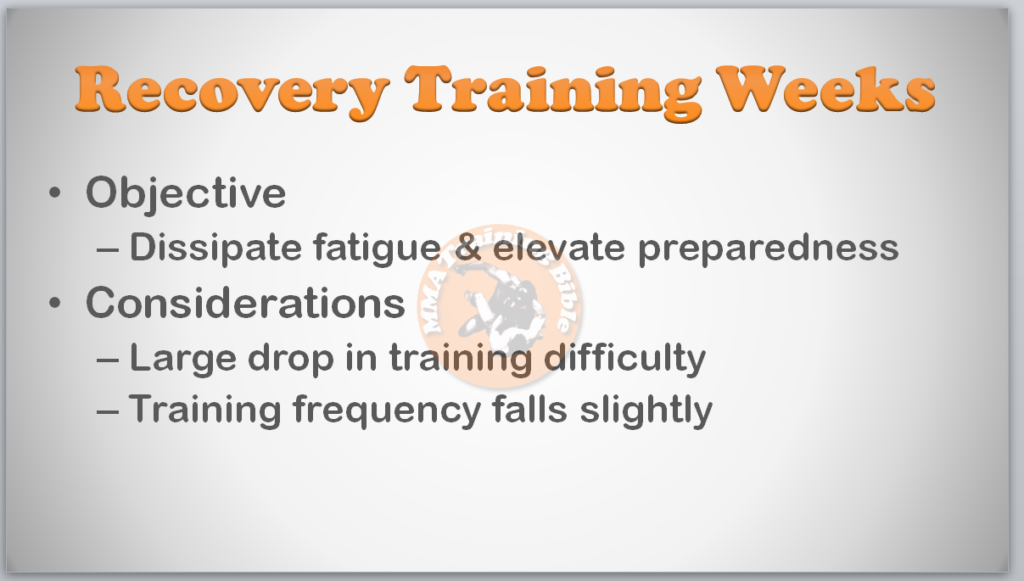
The recovery week has a much lower training difficulty than other weeks (Remember, you can decrease the difficulty of any training week by lowering the intensity, volume, or number of training sessions, or some combination of each).
Recovery training weeks typically contain training sessions that have slightly longer warm-ups, lighter workloads, and they are typically shorter in length than the training sessions of other weeks. To reduce monotony, coaches can intersperse games or fun activities, or special events into recovery training weeks. For example, beginner/intermediate fighters may play a game of basketball, or advanced fighters may instruct technical classes for beginners.
Developmental training weeks
These training weeks are used throughout your fight plan. Their objective is to increase the level of your physiological adaptation to training, develop technical and tactical abilities, and improve performance factors such as strength and power or aerobic and anaerobic endurance, or agility.
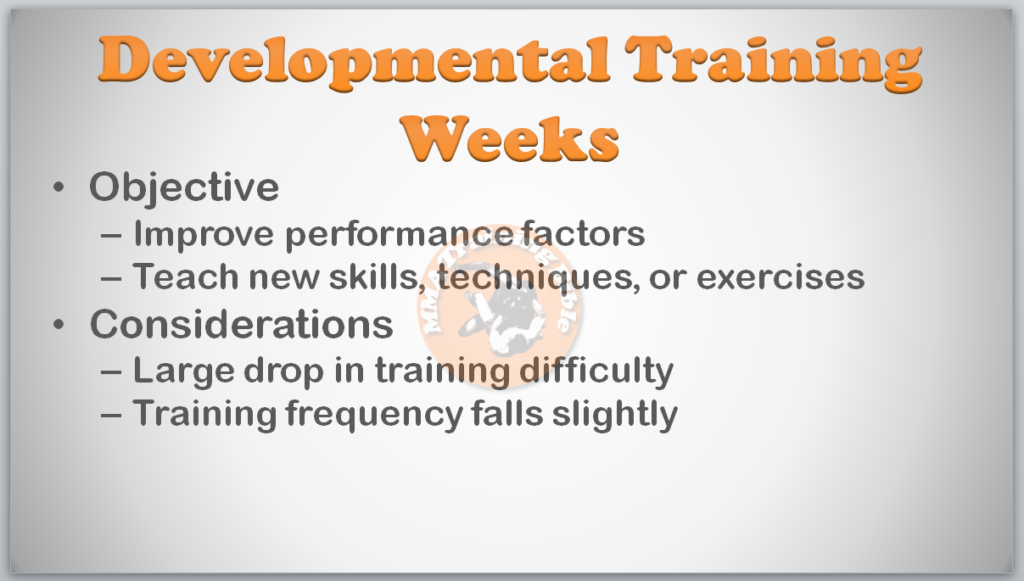
Shock training weeks
Shock training weeks contain a planned increase in training difficulty, which can be achieved by increasing the number of sessions per week, increasing the difficulty of the exercises (i.e. by using higher power-output exercises), and/or by increasing the volume and intensity of each workout. The whole point of the shock training week is to cause a greater level of physiological adaptation, which will improve your performance if you allow it to, by for example, taking a recovery week after it (otherwise, you could increase your chances of over-training!).
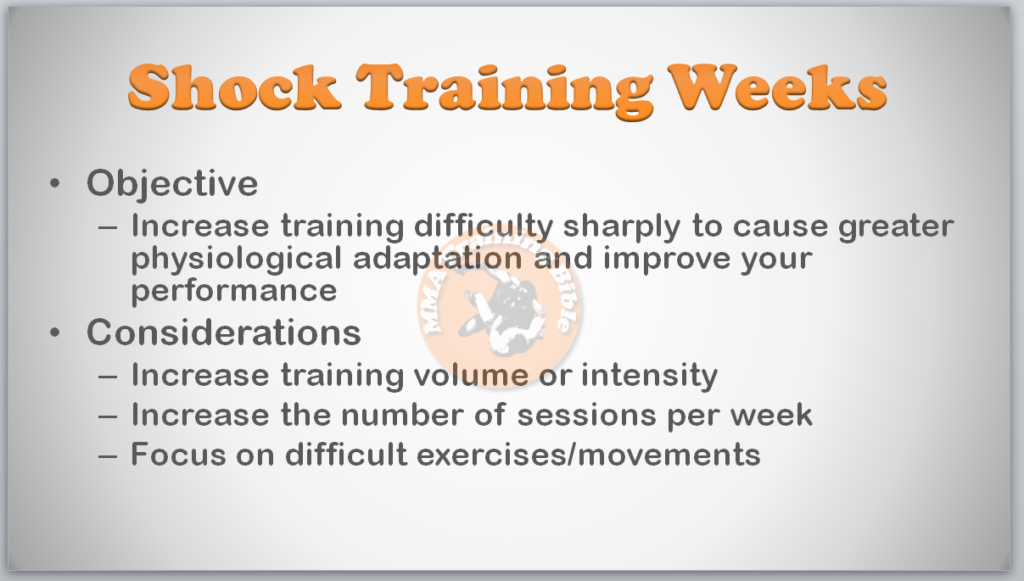
Taper (peaking) weeks
A taper normally takes up the 2 weeks before your fight. During the first week of the tapering period, training frequency should be maintained at around 80 % of pre-taper values in order to maintain technical proficiency (1). Training difficulty will fall by 40 % to 60 % over the first week, and by another 10 % to 20 % in the second week of the taper (1).
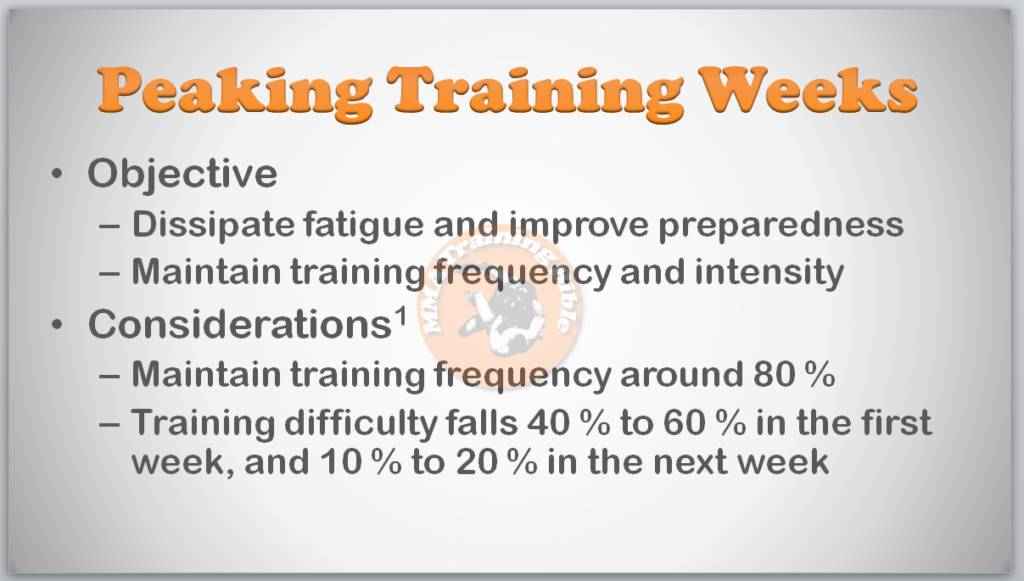
During the taper, the fighter should incorporate several short, but high intensity training sessions (not more than two or three) that use long rest intervals in order to dissipate fatigue. The high intensity training will also help to maintain physiological adaptations from previous training. Strength training should be reduced to one or two sessions, all other session should be very low intensity, focusing on tactical preparation (1). The final week of the taper should feature just a few (i.e. one or two) high intensity sessions early in the week.
Transition training weeks
The transition features a combination of recovery and developmental training weeks.
Example of how to schedule training weeks
Ok, I want to give you an example of how to schedule these training weeks into your fight plan.
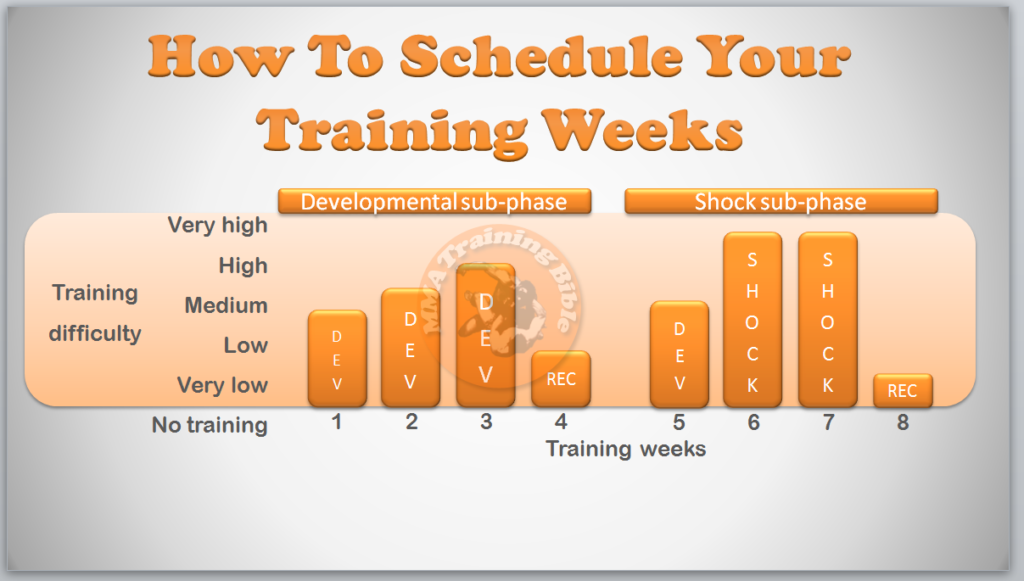
In the above figure, you can see a developmental sub-phase followed by a shock sub-phase. The developmental sub-phase will only use developmental training weeks. These weeks should feature a very smooth and gradual progress in training difficulty across the sub-phase, followed by one recover week with a training difficulty that is lower than the first developmental training week.
The subsequent shock sub-phase will use a combination of developmental and shock training weeks. In this example, one developmental training week (week 5) is followed by two shock weeks (weeks 6 and 7). Note the sharp increase in training difficulty as this fighter moves from week 5 to week 6 (this is what makes it a shock training week). In this example, two shock training weeks are used back-to-back (weeks 6 and 7). This is an advanced technique that will induce a period of overreaching; hence, a very low difficulty recovery week is required in week 8.
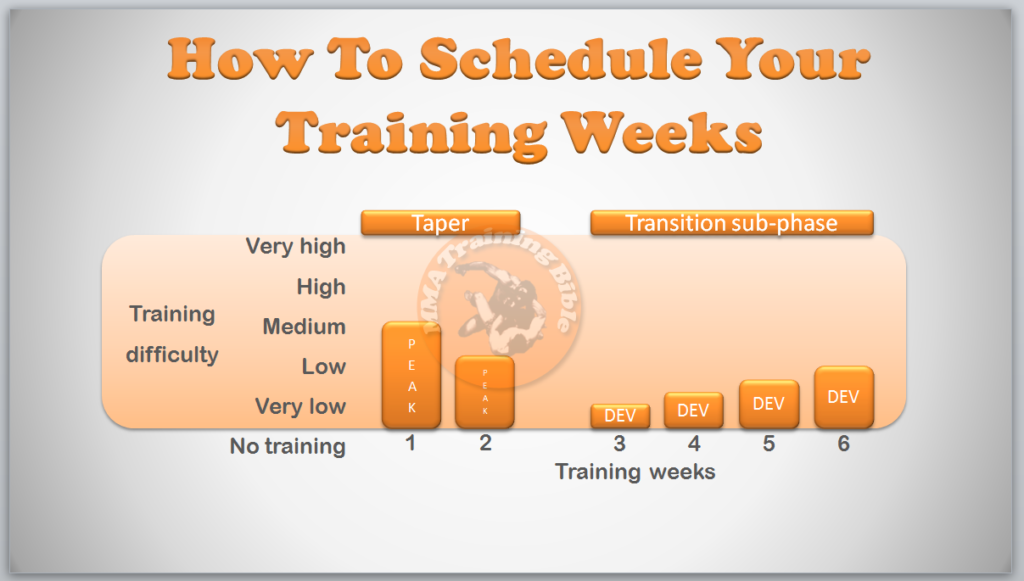
In the above example, you can see how to incorporate peaking weeks in the taper sub-phase, and developmental training weeks in the transition sub-phase. The most important thing to note about the peaking weeks of the taper sub-phase is that they feature a drop in training difficulty as the fight draws nearer. The training weeks of the transition sub-phase start with a very low level of training difficulty and gradually progress gradually, with the aim of preparing the fighter for the start of the next fight plan.
How many training sessions per week should I complete?
Beginners can generally tolerate two to three MMA specific sessions per week, additional endurance, strength/power or agility training sessions can be added thereafter, and may even have a positive influence on a fighter’s technical development, as there is a strong relationship between strength and technical ability (3).
Highly trained fighters can tolerate more sessions per day and per week, and can train at a higher intensity in each session compared to beginners, as shown in the table below (2)
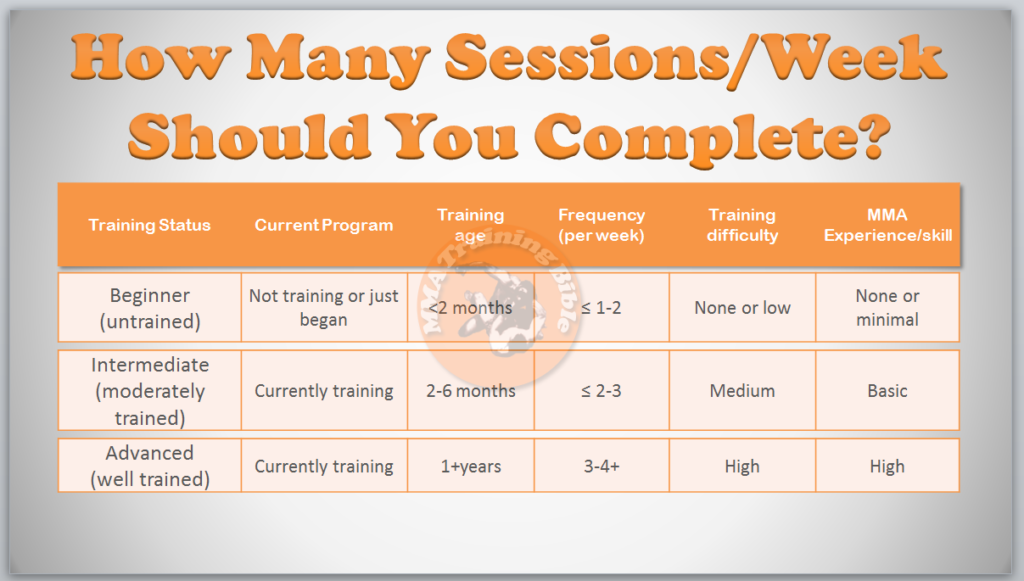
You should aim to progressively increase the number of weekly training sessions you complete, because this will result in a greater training stimulus (and adaptation), but additional sessions should only be added if the you can tolerate the current training load (MMA specific training).
Also, each new session must start with a low training difficulty and fulfill a specific purpose; for example, if you need to build power, that should be the focus, or if you must to develop agility, that’s the goal. Check out the figure below for an example of how a beginner fighter can build up their weekly training sessions.
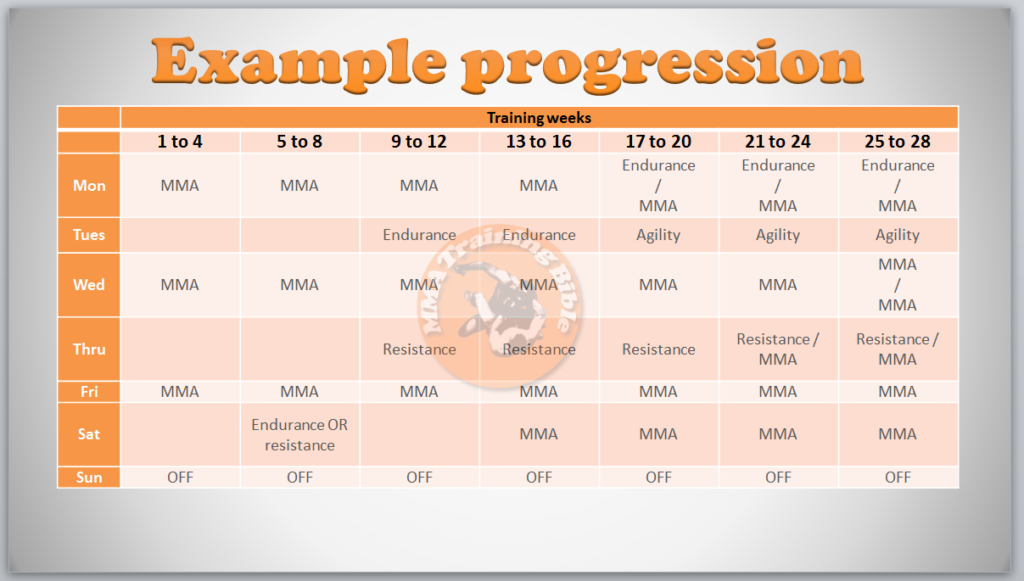
It is important to remember that every fighter must have their own individually designed training week; you can’t just copy my examples and expect to use them for yourself because they are made for individuals with very specific needs.
If you study go through the material I’m giving you, you should be able to put your own training plan together, but if you need coaching, I’m here for you; just your question below the article.
So that is an overview of how and why the MMA Training Bible structures its training weeks the way it does. And we’re nearly at the end of this article, but before we end, I want to recap with the take-home messages.
Take home messages
In this article, you learned that there are four different types of training weeks (recovery, developmental, shock, peaking) and you learned how to plan and sequence them across your fight plan.
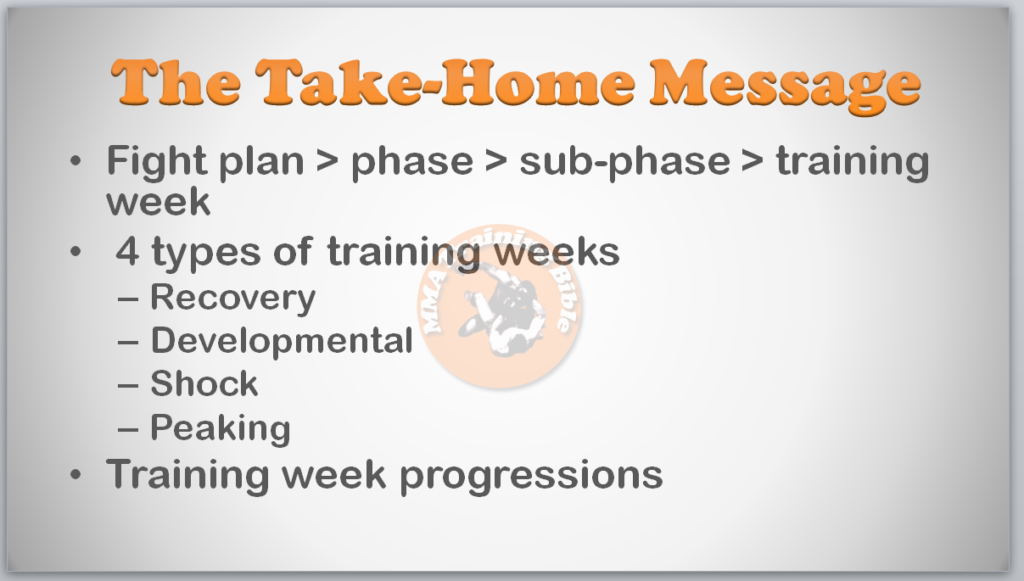
If you’re interested in this article series or others from The MMA Training Bible, please sign up to our email list at the bottom of the page and you’ll get an email whenever we post a new article. Also, don’t forget to share it with your training partners.
I hope you enjoyed this article and found it useful, stay tuned for the next one – and don’t be afraid to ask questions; this stuff can be a little confusing and I’m here to help!
Check out the next article in the series here: Part 5.
Sincerely,
Dr Jason Gillis
References and further study

Leave a Reply